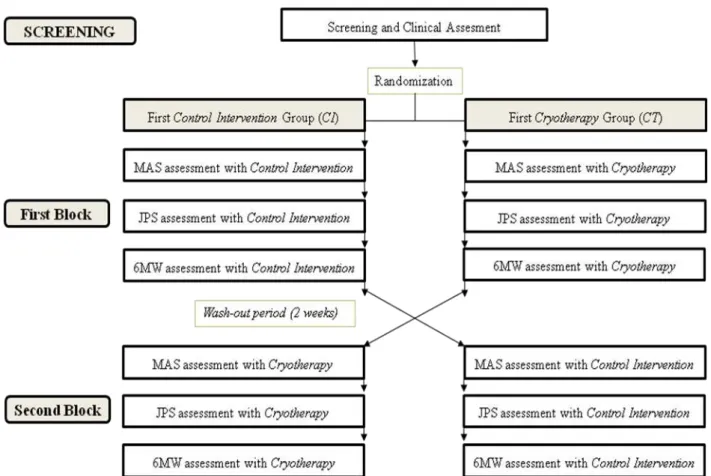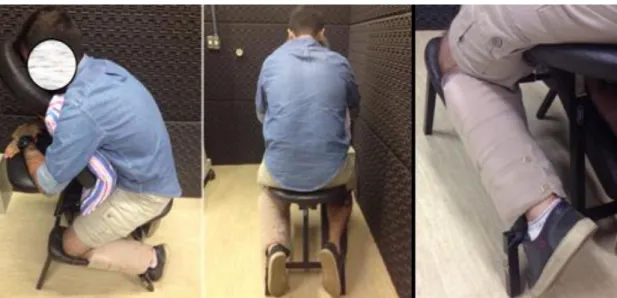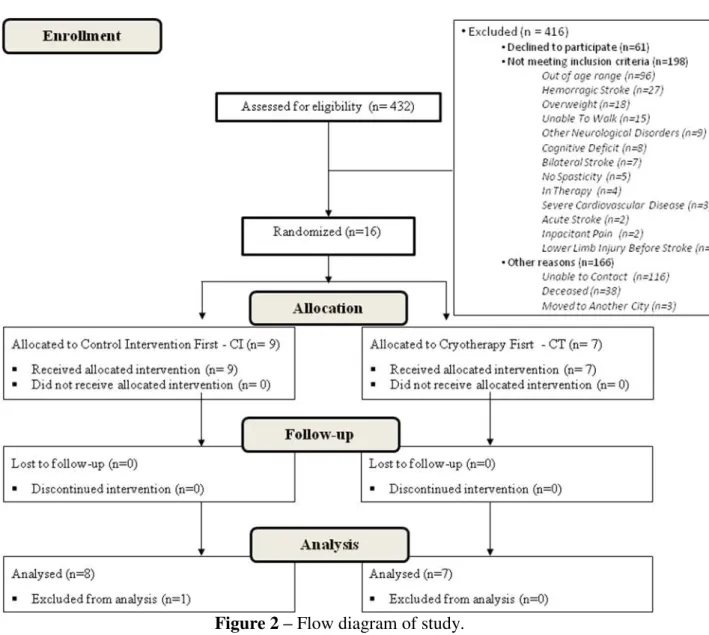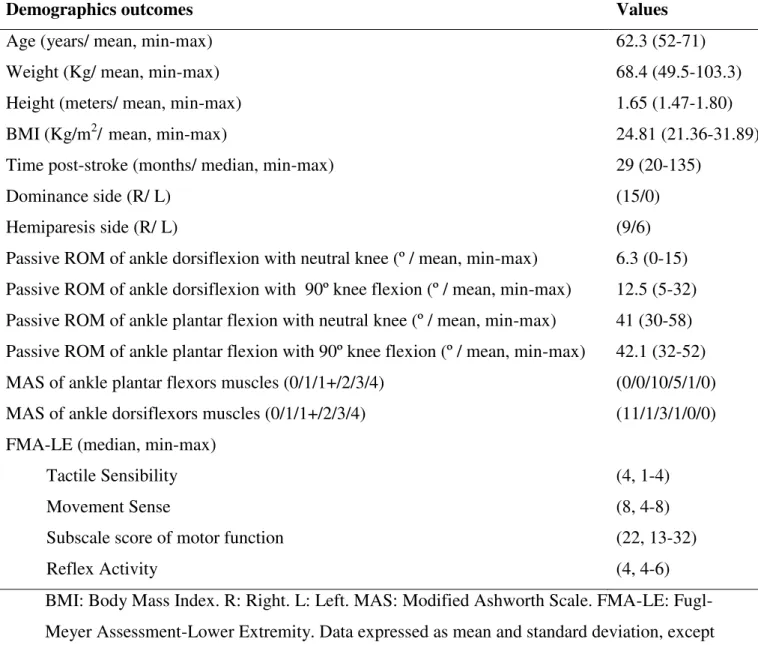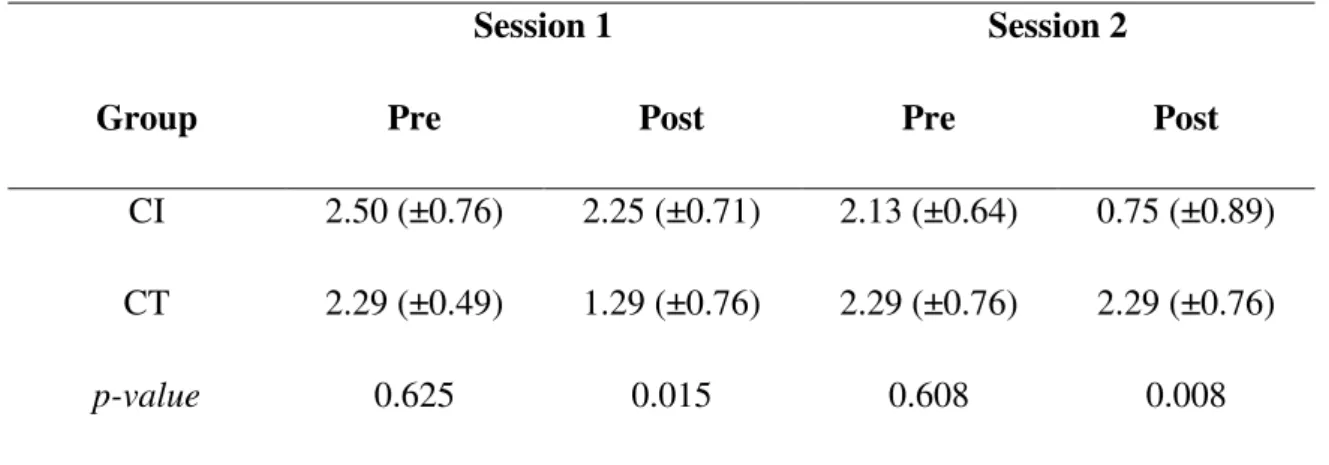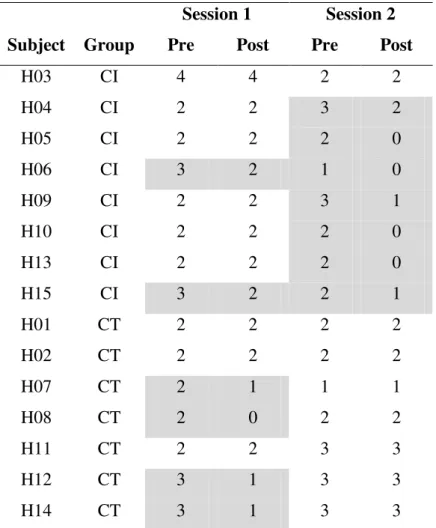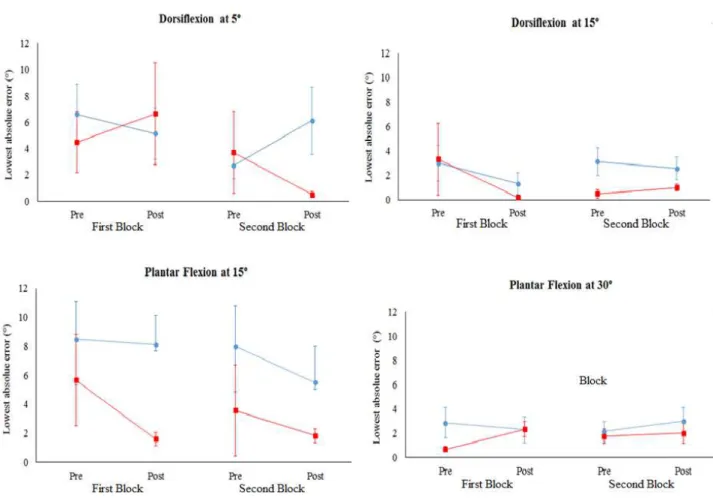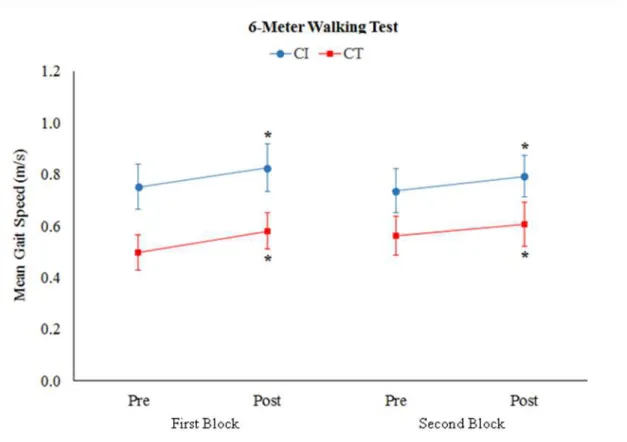UNIVERSIDADE FEDERAL DE SÃO CARLOS
CENTRO DE CIÊNCIAS BIOLÓGICAS E DA SAÚDE (CCBS) DEPARTAMENTO DE FISIOTERAPIA
A CRIOTERAPIA REDUZ A ESPASTICIDADE MUSCULAR,
MAS NÃO ALTERA O SENSO DE POSIÇÃO ARTICULAR E A
VELOCIDADE DA MARCHA EM PACIENTES CRÔNICOS
PÓS-AVC: UM ENSAIO CLÍNICO CROSSOVER
RANDOMIZADO E CONTROLADO
LUCCAS CAVALCANTI GARCIA
CENTRO DE CIÊNCIAS BIOLÓGICAS E DA SAÚDE (CCBS) DEPARTAMENTO DE FISIOTERAPIA
A CRIOTERAPIA REDUZ A ESPASTICIDADE MUSCULAR,
MAS NÃO ALTERA O SENSO DE POSIÇÃO ARTICULAR E A
VELOCIDADE DA MARCHA EM PACIENTES CRÔNICOS
PÓS-AVC: UM ENSAIO CLÍNICO CROSSOVER
RANDOMIZADO E CONTROLADO
LUCCAS CAVALCANTI GARCIA
Orientador: Prof. Dr. Thiago Luiz de Russo
SÃO CARLOS 2017
AGRADECIMENTOS
Agradeço em primeiro lugar a TODA minha família, meu bem mais precioso e minha fundação. Com algumas palavras apenas pra tentar explicar o significado do apoio e inspiração que cada um vocês me deu me sinto injusto, pois isso mereceria uma nova dissertação. Dedico meu esforço aos meus grandes amores, meus pais (Fábio e Luciana), aos meus ídolos e protetores, meus avós (Ulisses e Cristina)
minhas irmãs maravilhosas (Duda, Beli e Dora) e em especial meu irmão e eterno melhor amigo
(Matheus) por sempre estarem ao meu lado, de longe ou de perto, acreditando em mim e incentivando minhas aspirações malucas, enaltecendo meu potencial, não me deixando desistir ou me levantando dos tropeços durante o caminho, me trazendo de volta à realidade quando necessário, apoiando minhas escolhas e respeitando minhas atitudes, escutando meus devaneios e medos quaisquer que fossem, acalmando minhas angústias e choros quando quis desistir. Vocês permeiam tudo na minha vida! Agradeço aos meus tios e primos, todos os agregados que fazem parte da minha vida, vocês foram e são todos fundamentais nesse meu caminho. Todos vocês são parte do mosaico maluco que sou hoje e de certa forma me trouxeram aqui. Amo a todos vocês incondicionalmente e espero continuar realizando tudo que sonhei e sonho com esse apoio.
Ao Prof. Dr. Thiago Luiz de Russo por ter aceitado me orientar em meio a um período totalmente maluco da minha vida, me recebido no laboratório com muito carinho, respeito e comprometimento, sabendo que paralelamente ao meu amor pela ciência eu trazia o recente anseio por ser médico, o que estou a um passo a menos de realizar agora. Sou eternamente grato por essa oportunidade, que me permitiu voltar a São Carlos e fazer tudo acontecer. De maneira compreensiva, escutou todas minhas angústias, problemas, dúvidas e me orientou durante todas as diferentes fases dessa empreitada, sempre incentivando meu crescimento profissional e pessoal, me cobrando de maneira justa e oferecendo toda a ajuda necessária. Obrigado de verdade por confiar em mim, permitindo que eu assumisse um papel que sempre sonhei, o de ser cientista. Pessoa, professor e cientista de caráter íntegro e competência extraordinária, admirável. Muito obrigado por ter assumido esse papel.
A todos os professores da UFSCar que contribuíram para minha formação e história nesta casa, em especial, ao Prof. Dr. Fábio Serrão que me deu a primeira oportunidade de pisar em um laboratório de verdade, ler artigos científicos e participar do sonho mais antigo que me lembro, impregnado na minha cabeça depois de muito assistir ao mundo de Beakman, e também à Prof. Drª Rosana Mattioli que me mostrou a Neurologia e outras coisas que acabaram por influenciar todas as escolhas futuras da minha vida. Vocês são realmente queridos.
deixar a ortopedia, mas com certeza esse período e todos os frutos dessa parceria foram fundamentais pras minhas conquistas. Este período em que estive no LAIOT foi de incomensurável aprendizado em todos os aspectos, afinal, não aprendi somente os primeiros passos para me tornar pesquisador, mas também a lidar com pacientes, a me organizar melhor como profissional e a trabalhar em equipe. As minhas companheiras de laboratório (Fer, Clara e Marcela) que dividiram comigo as tardes de trabalho, as dicas de leitura, diversos ensinamentos e anseios, além das dúvidas em relação à todo o processo de elaboração da dissertação. Agradeço em especial as companheiras de pesquisa (Carol e Gabi) por me receberam como um irmão no laboratório, em todo meu processo de elaboração e realização do trabalho e do aprendizado, além de terem me aturado presencialmente por um ano e mentalmente por dois. Válido ressaltar também que toda a realização da atual pesquisa teria sido impossível sem a ajuda de ambas, desde conseguir voluntários até publicar os artigos, então me faltam palavras pra expressar meu agradecimento, devo muito a vocês. Um grande agradecimento à Carol, por ter sido uma fiel companheira e orientadora nas coletas, trabalhando com uma eficiência absurda e sempre feliz quando os voluntários compareciam às coletas e os sistemas resolviam funcionar.
Aos meus alunos de iniciação, João e Kevllyn pela dedicação e compromisso com a execução deste trabalho.
Aos meus sensacionais amigos da querida São Carlos (em especial minha crew, DxTxDx) que sempre estiveram presentes e ativos em cada pensamento e decisão da minha vida, torcendo pra minha realização, me servindo de cérebros auxiliares e sendo os principais fornecedores de diversão, alegria, companheirismo e inspiração durante esses anos todos, na vida pessoal, acadêmica ou qualquer outra possível. Cada um de vocês sabe da minha consideração, e agradeço a amizade de vocês como agradeço o oxigênio e a glicose que me mantém em pé!
Agradeço em especial à minha inestimável amiga Giuliana, por partilhar sempre seu caminho por entre as dificuldades e alegrias que enfrentamos na vida, e também suas escolhas. Sem seu apoio, a caminhada seria muito difícil ou até mesmo não teria existido em determinados pontos. Você foi fundamental, essencial para que eu tivesse força e determinação pra escapar do mundo das idéias e transformá-las em decisões, e essas decisões concretizassem as realizações que definiram meu futuro. Seu apoio foi meu porto seguro numa fase crucial, e todo o amor e confidência partilhados nunca serão esquecidos. Obrigado de verdade.
Ao casal de amigos, Yuri e Carol, que conheço há um bom tempo, fundamentais nessa conquista, incentivando a respirar nos momentos difíceis e não desanimar. Muito obrigada pelos rolês todos, pela diversão, carinho e a comilança!
correios. Com certeza sabem o quanto foram fundamentais para essa conquista. Agradeço imensamente por me escutarem falar durante horas madrugada adentro na memelândia, por me aconselharem, dividirem comida e serem ótimos parceiros! Jacaré meu atual parceiro de república que têm se mostrado um grande incentivador da minha carreira e parceiro pra qualquer empreitada. Com certeza não tenho palavras que transmitem tudo que eu gostaria, mas fica aqui escrito o meu agradecimento!
A todos meus parceiros deixados na UFF Niterói, e meus parceiros mais recentes da UFTM em Uberaba, os quais sei que se tornarão grandes amigos e quase sem me conhecer direito me incentivam e admiraram desde o princípio, o meu mais sincero e humilde obrigado.
Aos Professores do Programa de Pós-Graduação em Fisioterapia da Universidade Federal de São Carlos.
Aos professores da banca examinadora: Profª Drª Eliza Azevedo, Profa Dra Rosana Mattioli, Profª Drª Tania de Fátima Salvini, Profa Dra Anna Carolyna Gianlorenço, pelas valiosas sugestões e correções que certamente enriqueceram e ainda enriquecerão este estudo.
A todos os voluntários que participaram deste estudo, pois sem a compreensão, afinco e colaboração de vocês isto tudo não seria possível.
“
RESUMO
Contextualização: A espasticidade é uma desordem neuromuscular que culmina em déficits funcionais em indivíduos pós-Acidente Vascular Cerebral (AVC). A crioterapia é um dos principais meios usados para diminuir temporariamente a espasticidade, contudo não é claro na literatura quais efeitos o resfriamento poderia causar no controle sensoriomotor em hemiparéticos. Não foi descrito na literatura se a crioterapia poderia interferir nas submodalidades de sensibilidade profunda destes indivíduos, como o senso de posição articular. Objetivos: Avaliar os efeitos imediatos da crioterapia (pacote de gelo) sobre o senso de posição articular do tornozelo, o nível de espasticidade e o desempenho na marcha de indivíduos hemiparéticos espásticos crônicos pós-AVC. Métodos: Este foi um estudo controlado com delineamento crossover que contou com a participação de dezesseis sujeitos hemiparéticos crônicos, randomizados em dois grupos: 1) aqueles que receberam a aplicação da crioterapia durante todo o primeiro bloco de avaliações e após quinze dias passaram pelo mesmo procedimento após a aplicação da intervenção controle (Grupo Crioterapia - CT) e 2) aqueles que receberam a aplicação da intervenção controle durante todo o primeiro bloco de avaliações e após quinze dias passaram pelo mesmo procedimento após a aplicação da crioterapia (Grupo Intervenção Controle - CI). O Senso de Posição Articular (JPS) do tornozelo foi mensurado através de um dinamômetro isocinético Biodex Multi-joint System 3, antes e imediatamente após 20 minutos de ambas as aplicações. O menor erro absoluto em relação ao teste proprioceptivo foi calculado e utilizado para determinar a propriocepção. O nível de espasticidade da musculatura do tornozelo foi pontuado de acordo com a Escala de Ashworth Modificada (MAS). O teste de caminhada de 6 metros (6MW) foi aplicado para determinar a velocidade da marcha dos participantes. Resultados: A crioterapia reduz o nível de espasticidade da musculatura do tornozelo, sem alterar o seu Senso de Posição Articular ou a velocidade da marcha dos indivíduos. Conclusão: A crioterapia (pacote de gelo) reduz o nível de espasticidade em indivíduos hemiparéticos espásticos crônicos, sem alterar o seu Senso de Posição Articular e os parâmetros temporais da marcha.
LISTA DE FIGURAS
Figura 1. Representação Esquemática do Desenho Experimental ... 21
Figura 1S. Posicionamento do Paciente Para a Aplicação da Intervenção... 25
Figura 2. Fluxograma do Estudo ... 28
Figura 3. Menor Erro Absoluto no Teste de Senso de Posição Articular ... 32
LISTA DE TABELAS
LISTA DE ABREVIATURAS E SIGLAS
WHO World Health Organization (Organização Mundial de Saúde) AVC Acidente Vascular Cerebral
LaFiN Laboratório de Pesquisa em Fisioterapia Neurológica
FMS - LE Fugl-Meyer Scale – Lower Extremity (Escala de Avaliação de Fulg-Meyer –
Membros Inferiores)
CT Cryotherapy Group (Grupo Crioterapia)
SUMÁRIO
APRESENTAÇÃO ... 12
CONTEXTUALIZAÇÃO ... 13
OBJETIVOS ...14
Objetivos Gerais ... 14
Objetivos Específicos ... 14
MANUSCRITO ... 15
INTRODUÇÃO ... 17
MÉTODOS ... 20
Participantes ... 21
Avaliação clínica ... 22
Medida da propriocepção ... 23
Análise dos dados ... 26
RESULTADOS ... 27
Participantes ... 27
Propriocepção ... 32
DISCUSSÃO ... 33
CONCLUSÃO ... 36
ATIVIDADES NO PERÍODO ... 37
APRESENTAÇÃO
A dissertação está estruturada de acordo com as recomendações do Programa de Pós-Graduação em Fisioterapia da UFSCar. Inicialmente será descrita uma breve contextualização do trabalho, seguida pelos objetivos do estudo. A seguir, é apresentado o manuscrito intitulado "Cryotherapy reduces muscle spasticity, but does not affect joint sense position and walking speed in chronic post stroke subjects: a randomized sham-controlled crossover study". Este manuscrito será submetido à American Journal of Physical Medicine and
Rehabilitation. Por fim, a conclusão do estudo, bem como as atividades desenvolvidas pelo
CONTEXTUALIZAÇÃO
O presente estudo faz parte de uma linha de pesquisa implementada no Laboratório de Pesquisa em Fisioterapia Neurológica (LaFiN). Esta dissertação de mestrado faz parte de um projeto maior do laboratório que verifica os efeitos da crioterapia no controle momentâneo da
espasticidade e seus desdobramentos sobre o controle sensório-motor, as propriedades mecânicas dos músculos espásticos e a funcionalidade em indivíduos pós-AVC.
Atualmente, há uma falta de consenso e evidência na literatura sobre uma série de mecanismos de ação do gelo em pacientes neurológicos. Apesar de bem descrita a redução da espasticidade após a crioterapia, não é claro o seu impacto sobre a sensibilidade e o
desempenho em tarefas funcionais. Neste estudo, foram abordadas as seguintes implicações clínicas: Seria a crioterapia capaz de alterar componentes da propriocepção em membros inferiores de indivíduos hemiparéticos espásticos? Haveria qualquer prejuízo ou facilitação para a marcha destes indivíduos?
OBJETIVOS
Objetivos Gerais
Avaliar os efeitos imediatos da crioterapia (pacote de gelo), aplicada sobre o músculo tríceps sural parético, sobre a espasticidade destes músculos, o senso de posição articular do tornozelo durante os movimentos de tornozelo, bem como sobre o desempenho da marcha, em indivíduos hemiparéticos crônicos.
Objetivos Específicos
Avaliar os efeitos imediatos da crioterapia (pacote de gelo), aplicada nos músculos tríceps surais paréticos de indivíduos hemiparéticos espásticos crônicos, sobre:
O senso de posição articular do tornozelo, mensurado pelo erro absoluto na angulação, em menores e maiores amplitudes de movimento para dorsiflexão e flexão plantar. O nível de espasticidade da musculatura do tornozelo parético, determinado pela
Escala de Ashworth Modificada.
MANUSCRITO
O artigo será submetido ao periódico American Journal of Physical Medicine and
Rehabilitation (fator impacto 2,04 e qualis A1) – Anexo I
Cryotherapy reduces muscle spasticity, but does not affect joint sense position and walking speed in chronic post stroke subjects: a randomized sham-controlled crossover study
Luccas Cavalcanti Garcia1, Carolina Carmona Alcântara1, MSc, Gabriela Lopes Santos1, MSc, João Victor Almeida Monção1, Thiago Luiz Russo1, PhD
1Laboratory of Neurological Physiotherapy Research, Department of Physical Therapy, Federal University of São Carlos (UFSCar), São Carlos, SP, Brazil
Abstract
Background: Spasticity is a neuromuscular disorder that causes functional impairments in post-stroke individuals. Cryotherapy is used to temporarily reduce spasticity, but its effects on sensorimotor control components, such as the joint position sense (JPS), and gait performance in hemiparetics individuals are still unclear. Objectives: To evaluate the immediate effects of cryotherapy (ice pack modality) on the spasticity level, ankle JPS and gait performance in chronic hemiparetic individuals post-stroke. Methods: Sham-controlled crossover design. Sixteen chronic hemiparetic subjects were randomized into two groups: 1) those who received cryotherapy and after fifteen days they received control intervention (Cryotherapy Group –
Introduction
Stroke, the second most common cause of death and the major cause of disability in adults worldwide, is often related with some degree of disability (Almeida, 2012), which impairs the working and daily living activities. Most of these impairments are related to the hemiparesis contralateral to the injured hemisphere. The hemiparesis can be characterized by motor control deficits, weakness and changes in muscle tone (Hsu et al., 2003; Lin et al., 2006). Previous data showed that even though 60% of individuals can walk after rehabilitation programs (Preston et al., 2011), deficits in the lower limbs function usually persist, affecting gait performance and functional mobility (Gerrits et al., 2009; Chisholm et al., 2013), which can be characterized by lower velocities and compensatory asymmetries (Hsu et al. 2003; Lin et al., 2006).
These deficits are often related to ankle dorsiflexor muscles weakness, spastic extensor pattern predominance, ankle joint stiffness, and proprioceptive deficits (Park et al., 2013). In particular, the ankle muscles spasticity has been reported as an important cause of spatial asymmetry during ambulation (Lin et al. 2006). Although spasticity is quite common among hemiplegic patients, its control is still a challenge for the rehabilitation team. Resources such as electrical stimulation, proprioceptive neuromuscular facilitation and cryotherapy are routinely used aiming to temporarily control spasticity and/or facilitate functional training. However, their effects and efficacy still lack studies (evidence-based practice).
blood flow reduction, decreased local metabolism and reduction in the sensory and motor nerve conduction velocity (Algafly & George, 2007, Herrera et al., 2011).
The studies which detected momentary spasticity reduction attribute this effect to the reduction of the sensitivity of the muscle spindle (Allison & Abraham, 2001). Moreover, spasticity reduction has already been related to the facilitation of alpha motoneurons and inhibition of the gamma system. However, the neurophysiological mechanisms that support the modulation of spasticity by cryotherapy appear to be much more complex, including cutaneous afferents and central nervous system inputs (Michlovitz, 1990). A previous study (Allison and Abraham, 2001) found that cryotherapy reduces ankle muscles spasticity, measured by the Modified Ashworth Scale, but hinders the performance on coordination tasks, such as performing alternating dorsiflexion and plantar flexion movements of the ankle in post-cranioencephalic trauma individuals. The authors argue that despite the cryotherapy is able to temporarily reduce spasticity, changes related to decreased motor and sensory nerve conduction velocity and increased stiffness as a result of muscles, nerves and joint cooling could impair the coordination activities that required speed.
Findings arising mainly from studies that investigated if cryotherapy interferes on
athletes’ performance have shown controversial results (Vieira et al., 2013; Hopkins &
Proprioception is divided into three submodalities: conscious or unconscious perception of joint position (joint position sense), movement (kinesthetic), and strength, weight and effort (sense of strength) (Röijezon et al., 2015).
Each proprioception submodality is mainly influenced by specific receptors, depending on their roles. The JPS is under muscle spindle great influence, because this receptor has the function of perception and afferent regarding the changes in muscle length. This submodality is important to the perception of the limb in space and, therefore, determine the required range of motion to complete the task (Yalcin et al., 2012). Recently, Yalcin and colleagues (2012) showed that post-stroke individuals had ankle joint position sense deficits during dorsiflexion and plantar flexion, with no relation to functional deficits. However, there is no available information in the literature regarding the interference of cryotherapy on joint position sense in hemiparetic individuals. Given that cryotherapy in often used in the clinical scenario, it is plausible to investigate and clarify if this intervention would have any negative effects on proprioception in spastic post-stroke subjects, likely compromising functional performance.
Methods Experimental design
This study presents a crossover, controlled, randomized design conducted at a single center in chronic hemiparetic patients. The research activities of this study received ethical approval by the Ethics Committee in Brazil (Number: 1.469.151) and it was registered in the Clinical Trials (NCT02736747). Written informed consent was obtained from each patient prior to taking part in the study.
Figure 1 – Schematic representation of the experimental design. JPS: Joint Position Sense. MAS: Modified Ashworth Scale. 6MW: 6-Meter Walk.
Participants
The following exclusion criteria were applied: peripheral neuropathy; adverse reactions to cold; intolerance to the ice pack application; lack of sensitivity to cold; presence of Raynaud's phenomenon; ulcers or skin lesions; serious cardiovascular or peripheral vascular disease (heart failure, arrhythmia or angina pectoris); any other orthopedic or neurological disorder; botulinum toxin application up to six months before the study; cognitive or communication disabilities; lower limbs joint or muscle previous injuries; pain during the assessment procedures.
Clinical assessment
The subjects underwent an interview, which included the medical history and physical examination performed by an experienced physiotherapist. The initial clinical assessment included the collection of anthropometric data, such as weight and height, the application of the Fugl-Meyer scale for lower limbs (FMA-LE) (Maki et al., 2006), and the evaluation of passive range of motion (ROM) for dorsiflexion and plantar flexion using a goniometer. These ROM measurements were performed with the knee in a neutral position and at 90° flexion.
Spasticity Evaluation
"normal tonus" or "no increase in muscle tone" to 4, "stiffness of affected part” or “limited range of motion” (Cho et al., 2013). For the analysis, these spasticity levels (0, 1, 1+, 2, 3, 4) were categorized in the following levels 0, 1, 2, 3, 4, and 5, respectively. The mean values before and after intervention were considered for analysis (Cho et al, 2013; Suh et al, 2014; Tsuchiya et al, 2016).
Joint Position Sense Evaluation (JPS)
Ankle joint position sense was evaluated by passive joint position test reproduction (Myers and Lephart, 2000; Lephart et al., 2002; Yalcin et al, 2012). This assessment was performed on an isokinetic dynamometer (Biodex Multi-joint System 3, Biodex Medical System Inc., New York). Before each test, the dynamometer was calibrated according to the
manufacturer’s guidelines. Individuals remained seated in a chair with the hip at 70° and knee
at 45° of flexion, with trunk stabilized by belts. Similarly, the hip and thigh were fixed to the dynamometer chair by strips according to the description of the equipment manual. The dynamometer rotation axis was aligned with the lateral malleolus and the foot was fixed on the device with strips assigned to the ankle joint. Moreover, during the testing, the individuals were blindfolded to exclude any possible visual cues. However, the individuals did not wear headphones because the communication with experimenter was necessary in order to guide them before and in the between of each test. No feedback was provided at any moment (Myers and Lephart, 2000; Niessen et al., 2008).
that the reference position had been reached, which corresponds to the indicated position. The stop button was held in the non-paretic hand. The dynamometer movement speed was 2° per second for each test. The absolute error was calculated as the difference between the reference position and the indicated position measured in degrees.
This procedure was performed three times for each reference position (5° and 15° dorsiflexion and 15° and 30° plantar flexion) before and immediately after the application of cryotherapy / control intervention. Thus, patients performed 12 repetitions pre-intervention and 12 repetitions post-intervention. The order for dorsiflexion and plantar flexion assessments was randomized to avoid possible learning effects. The order of the tested angles was always from the lowest to the highest range of motion (5° followed 15° of dorsiflexion, and 15° followed 30° of plantar flexion).
Walking evaluation
Participants performed a 6-meter walking test (6MW). They were instructed to walk barefoot, at a self-selected and comfortable speed along a 10-meter walkway (Kinsella and Moran, 2008). The walkway was divided in three parts: participants started walking 2 meters before the 6 meters collection area, and finished 2 meters after it. This procedure was performed in order to discard from the assessment the initial stages of acceleration and deceleration.
Intervention
For both interventions, cryotherapy and control, participants dressed comfortable and stayed for 15 minutes in the room with controlled temperature (25°C) for acclimatization. A rectangular area was defined to position the package as described by Herreira et al., 2010. Then, the participants were positioned in a comfortable chair for the intervention application (Supplementary material Fig. 1S).
Figure 1S – Patient positioning in the massage chair for the application of cryotherapy/ control intervention.
For the cryotherapy intervention, package (25 x 35cm) was filled with 1000g of crushed ice, no air, tied on the leg using a non-compressive elastic band (Herrera et al., 2010). For the control intervention, the package was filled with 1000 g of sand, at room temperature, also without air, so that the pressure was similar to the ice pack, in order to prevent any variables besides temperature interfering with the analysis.
Outcome measures
The primary outcome variable in this study was ankle JPS, expressed by the lowest absolute error value among repetitions, in degrees, for the paretic limb measured before and after interventions (cryotherapy and control) in the first and second evaluation blocks. Secondary outcome variables were the spasticity level measured by the categories of MAS (0, 1, 2, 3, 4, and 5), and the gait speed (m/s) asessed during the 6MW test. Both variables were also measured before and after intervention (cryotherapy and control) in both evaluation blocks.
Statistical analysis
Statistic tests were performed using SPSS software, version 17.0 (SPSS Inc., Chicago, IL, USA). As the level of spasticity is a categorical variable, Wilcoxon test was performed to compare spasticity level during pre and post-intervention (cryotherapy and control). In addition, Mann-Whitney test was used to compare groups in each evaluation. For both tests, a significance level of 0.05 was considered.
intervention (cryotherapy and control) for each group. A significance level of 0.008 was set considering the Bonferroni adjustment . To compare groups in each evaluation (pre and post cryotherapy or control intervention), the Kruskal-Wallis test with Bonferroni adjustment was used. A significance level of 0.0125 was considered.
On the other hand, gait speed during 6-Meter Walk test showed normality and homogeneity. Therefore, a mixed model, two-way ANOVA (group and evaluation time) with repeated measures (evaluation time: pre and post - control or cryotherapy intervention) with
Bonferroni’s correction was used to verify the effect of group-by-evaluation interaction. A significance level of 0.05 was considered.
Results Participants
A total group of 432 hemiparetic subjects from local community and hospital of São Carlos were assessed for eligibility. Sixteen subjects met the entire inclusion criterion and agreed to participate. Among the excluded patients, 61 declined to participate, 198 did not meet inclusion criteria, and 166 were excluded for other reasons. Thus, 16 subjects (2 women and 14 men) were randomized into two groups: cryotherapy followed by control intervention (n=9, CT) or control intervention followed by cryotherapy (n=7, CI). All included patients completed the crossover experiment. However, data analysis was successfully conducted in 15 of 16 participants, because one of them did not provide sufficient valid absolute error values during the JPS assessment (did not indicate the reference position before reaching its own maximum range of motion for the test) (Figure 5).
variable that presented the highest sample size after calculation. A power of 0.80 and alpha of 0.05 was considered, requiring a total sample size of 12.
Figure 2 – Flow diagram of study.
with 1 score, 3 with a 1+ score and 1 with 2 score. None presented 3 or 4 score on MAS for plantar flexion. The median score of FMA-LE for motor function was 22 (range 13-32). Table 1 – Demographic characteristic of participants
Demographics outcomes Values
Age (years/ mean, min-max) 62.3 (52-71)
Weight (Kg/ mean, min-max) 68.4 (49.5-103.3)
Height (meters/ mean, min-max) 1.65 (1.47-1.80)
BMI (Kg/m2/ mean, min-max) 24.81 (21.36-31.89)
Time post-stroke (months/ median, min-max) 29 (20-135)
Dominance side (R/ L) (15/0)
Hemiparesis side (R/ L) (9/6)
Passive ROM of ankle dorsiflexion with neutral knee (º / mean, min-max) Passive ROM of ankle dorsiflexion with 90º knee flexion (º / mean, min-max)
6.3 (0-15) 12.5 (5-32) Passive ROM of ankle plantar flexion with neutral knee (º / mean, min-max)
Passive ROM of ankle plantar flexion with 90º knee flexion (º / mean, min-max)
41 (30-58) 42.1 (32-52) MAS of ankle plantar flexors muscles (0/1/1+/2/3/4) (0/0/10/5/1/0)
MAS of ankle dorsiflexors muscles (0/1/1+/2/3/4) (11/1/3/1/0/0)
FMA-LE (median, min-max) Tactile Sensibility Movement Sense
Subscale score of motor function Reflex Activity
(4, 1-4) (8, 4-8) (22, 13-32) (4, 4-6) BMI: Body Mass Index. R: Right. L: Left. MAS: Modified Ashworth Scale. FMA-LE: Fugl-Meyer Assessment-Lower Extremity. Data expressed as mean and standard deviation, except time post-stroke expressed as mean (minimum-maximum), and subscales score of FMA-LE as median (maximum-minimum).
Spasticity evaluation
p=0.015, and control, p=0.008) (Table 2). Table 1S shows absolute values of level spasticity for each individual, group and assessment time (See supplementary material).
Table 2 – Modified Ashworth Scale mean, standard deviation and p values for each group by assessment time.
Session 1 Session 2
Group Pre Post Pre Post
CI 2.50 (±0.76) 2.25 (±0.71) 2.13 (±0.64) 0.75 (±0.89) CT 2.29 (±0.49) 1.29 (±0.76) 2.29 (±0.76) 2.29 (±0.76)
p-value 0.625 0.015 0.608 0.008
Table 1S – Modified Ashworth Scale absolute values for each individual, group and assessment time.
Session 1 Session 2 Subject Group Pre Post Pre Post
H03 CI 4 4 2 2
H04 CI 2 2 3 2
H05 CI 2 2 2 0
H06 CI 3 2 1 0
H09 CI 2 2 3 1
H10 CI 2 2 2 0
H13 CI 2 2 2 0
H15 CI 3 2 2 1
H01 CT 2 2 2 2
H02 CT 2 2 2 2
H07 CT 2 1 1 1
H08 CT 2 0 2 2
H11 CT 2 2 3 3
H12 CT 3 1 3 3
H14 CT 3 1 3 3
CI: Control Intervention First; CT: Cryotherapy First. Gray filled spaces highlight in which session the
individuals presented a reduction in the spasticity level.
Joint position sense
For both groups (CI and CT), there were no effects of cryotherapy and control
intervention during dorsiflexion at 5° (p=0.085 and p=0.172), dorsiflexion at 15° (p=0.147
and p=0.136) plantar flexion at 15° (p=0.404 and p=0.096) and plantar flexion at
30° (p=0.552 and p=0.145). Moreover, no differences between groups were observed before
both intervention in first and second sessions during dorsiflexion at 5° (p=0.202 and
p=0.268), dorsiflexion at 15° (p=0.476 and p=0.067), plantar flexion at 15° (p=0.093 and
p=0.019) and plantar flexion at 30° (p=0.517 and p=0.183). No differences between groups
5° (p=0.343 and p=0.048), dorsiflexion at 15° (p=0.476 and p=0.610) plantar flexion at
15° (p=0.030 and p=0.354) and plantar flexion at 30° (p=0.667 and p=0.383) (Figure 3).
Figure 3 - Lowest absolute error for dorsiflexion at 5° and 15°, and plantar flexion at 15° and 30° for control intervention first (CI) and cryotherapy first (CT) groups pre and post intervention at first and second session. Data expressed as mean and standard deviation. No effects were
observed for cryotherapy and control intervention for both groups.
Walking evaluation
first (p=0.002) and second sessions (p=0.008), regardless of the intervention applied (cryotherapy or control) (Figure 4).
Figure 4 - Mean Gait Speed (m/s) in the 6-Meter Walking test (mean and standard deviation). CI:
Control Intervention First. CT: Cryotherapy First. There was no effect of group-by-evaluation
interaction and group. However, higher gait velocity values were observed after intervention, regardless of the intervention applied. *Significant differences compared to pre-intervention (p<0.05).
Discussion
speed. Although the results are not in line with our hypothesis, these findings bring us important clinical evidence involving a resource widely used in neurological clinical practice.
According to literature, the cryotherapy is an efficient intervention for momentary muscle spasticity reduction, probably related to decreased motor and sensory nerve conduction velocity (NCV) (Algafly & George, 2007) and to changes in the spinal reflexes (Hopkins et al., 2002). One previous study (Hopkins et al., 2002) reported that muscle cooling reduced NCV, muscle spindle firing rates, and monosynaptic reflex amplitudes in healthy subjects. Although these potential neurophysiological mechanisms might explain the decrease in spasticity level post cryotherapy in the present study, more research is needed to confirm this hypothesis.
Another important result of the present study involves the absence of cryotherapy effects in JPS. According to literature review, the effects of cryotherapy on the JPS still inconclusive even in healthy subjects, which may be due to methodological differences between the studies, such as assessed joint, applied modality and measurement techniques (Costello & Donnelly, 2010). While some studies have shown that cryotherapy impaired JPS in healthy subjects and athletes when compared to a control assessment (Hopper et al., 1997; Oliveira et al., 2009; Uchio et al., 2003; Watanabe et al., 2013), justifying these changes by a greater reduction in intramuscular temperature, joint cooling, reduced NCV, or cold-induced changes in proprioceptive function, others showed that cryotherapy did not significantly alter JPS (Dover & Powers, 2004; Eftekhari et al., 2015; Someh et al., 2011; LaRiviere & Osternig, 1994; Ozmun et al., 1996; Pritchard & Saliba, 2014; Surenkok et al., 2008; Wassinger et al., 2007).
significant role. Therefore, whether superficial applications of cryotherapy can cool deep tissue sufficiently to elicit impairments on JPS is still questionable.
Moreover, the present study did not observed effects on gait performance, which was in line with previous study that did not observe deleterious effects on static and dynamic balance, and vertical jump performance in healthy subjects (Williams et al., 2013). These authors reported that afferent information from the joint may have been affected by the ice application, but subjects could have been able to use peripheral information from different areas to modify the motor response. It is argued that any little afferent information travels to the CNS seems to be enough for the central command information to correct the JPS (Dover & Powers, 2004). Although no effects of cryotherapy on gait were observed, our results revealed an increase in walking speed after intervention, regardless of the type of intervention. This result can be justified by a learning effect, after many repetitions of the task.
In addition differences between limbs and the local of ice application could also explain the differences between the present results and the literature. The upper limb coordination, for example, could be more affected by proprioceptive disturbances than lower limb, considering its function of performing fine movements (Santos et al., 2016). Recently, a study showed that tactile stimuli provided by elastic taping improved shoulder’s sense
position in chronic post-stroke subjects (Santos et al., 2017). Based on this, it is possible to suppose that ice pack applied over the muscle can generate different effects than applied over the joint.
However, it is worth noting that these results are limited to effects of ice package in chronic hemiparetic subjects with low and moderate levels spasticity (between 1 and 3) and independent walking (with or without aid).
Conclusion
ATIVIDADES NO PERÍODO
Durante todo o período do mestrado, estive envolvido em outros trabalhos e atividades discentes além do estudo apresentado. Atualmente, estive envolvido no processo de análise dessas avaliações e elaboração dos manuscritos. Para a execução do trabalho, participei de cursos e palestras pertinentes em relação instrumentos de avaliação e variáveis que eu utilizei. Durante o ano de 2015 participei do projeto de extensão “Grupo terapêutico para
indivíduos hemiparéticos crônicos” na Unidade Saúde Escola (USE) da Universidade Federal de São Carlos (UFSCar). Neste período, também estive envolvido com co-orientações de
alunos da graduação e participei do
Curso de Capacitação em Terapia por Contensão Induzida: Infantil e Adulto realizado no Departamento de Fisioterapia da Universidade Federal de São Carlos (UFSCar). Além destas atividades, fui aluno de um curso pré-vestibular (2015) e iniciei minha graduação em Medicina na Universidade Federal Fluminense (UFF – 1/2016), a qual atualmente está ativa na Universidade Federal do Triângulo Mineiro (UFTM – 2/2016).
E. M. ; SERRAO, F. V. . Lower limb strength and flexibility in athletes with and without patellar tendinopathy. Physical Therapy in Sport, v. 20, p. 19-25, 2016).
REFERÊNCIAS BIBLIOGRÁFICAS
ALGAFLY, Amin A.; GEORGE, Keith P. The effect of cryotherapy on nerve conduction
velocity, pain threshold and pain tolerance. British journal of sports medicine, v. 41, n. 6, p.
365-369, 2007.
ALLISON, Stephen C.; ABRAHAM, Lawrence D. Sensitivity of qualitative and quantitative
spasticity measures to clinical treatment with cryotherapy. International Journal of
Rehabilitation Research, v. 24, n. 1, p. 15-24, 2001.
ALMEIDA, Sara Regina Meira et al. Análise epidemiológica do acidente vascular cerebral no
Brasil. Rev Neurocienc, v. 20, n. 4, p. 481-2, 2012.
BOHANNON, Richard W.; SMITH, Melissa B. Interrater reliability of a modified Ashworth
scale of muscle spasticity. Phys ther, v. 67, n. 2, p. 206-207, 1987.
BOUDARHAM, Julien et al. Variations in kinematics during clinical gait analysis in stroke
patients. PloS one, v. 8, n. 6, p. e66421, 2013.
CAREY, Leeanne M. Somatosensory loss after stroke. Critical Reviews™ in Physical and
CHISHOLM, Amanda E.; PERRY, Stephen D.; MCILROY, William E. Correlations between
ankle–foot impairments and dropped foot gait deviations among stroke survivors. Clinical
Biomechanics, v. 28, n. 9, p. 1049-1054, 2013.
CHO, Hwi-Young et al. A single trial of transcutaneous electrical nerve stimulation (TENS)
improves spasticity and balance in patients with chronic stroke. The Tohoku journal of
experimental medicine, v. 229, n. 3, p. 187-193, 2013.
COSTELLO, Joseph T.; DONNELLY, Alan E. Cryotherapy and joint position sense in
healthy participants: a systematic review. Journal of Athletic Training, v. 45, n. 3, p.
306-316, 2010.
DOVER, Geoffrey; POWERS, Michael E. Cryotherapy does not impair shoulder joint
position sense. Archives of physical medicine and rehabilitation, v. 85, n. 8, p. 1241-1246,
2004.
EFTEKHARI, Fereshteh et al. The effect of local cooling on knee joint position sense in
healthy trained young females. International Journal of Sport Studies, v. 5, n. 6, p.
700-707, 2015.
FAUL, Franz et al. G* Power 3: A flexible statistical power analysis program for the social,
behavioral, and biomedical sciences. Behavior research methods, v. 39, n. 2, p. 175-191,
GERRITS, Karin H. et al. Isometric muscle function of knee extensors and the relation with
functional performance in patients with stroke. Archives of physical medicine and
rehabilitation, v. 90, n. 3, p. 480-487, 2009.
HATZEL, Brian M.; KAMINSKI, Thomas W. The effects of ice immersion on concentric and
eccentric isokinetic muscle performance in the ankle. Isokinetics and exercise science, v. 8,
n. 2, p. 103-107, 2000.
HERRERA, Esperanza et al. Motor and sensory nerve conduction are affected differently by
ice pack, ice massage, and cold water immersion. Physical therapy, v. 90, n. 4, p. 581, 2010.
HERRERA, Esperanza et al. Effect of walking and resting after three cryotherapy modalities
on the recovery of sensory and motor nerve conduction velocity in healthy subjects. Brazilian
Journal of Physical Therapy, v. 15, n. 3, p. 233-240, 2011.
HOPKINS, J. Ty; STENCIL, Rhonda. Ankle cryotherapy facilitates soleus function. Journal
of Orthopaedic & Sports Physical Therapy, v. 32, n. 12, p. 622-627, 2002.
HOPPER, Diana; WHITTINGTON, Dean; CHARTIER, Jennifer Davies. Does ice immersion
influence ankle joint position sense?. Physiotherapy Research International, v. 2, n. 4, p.
223-236, 1997.
HSU, An-Lun; TANG, Pei-Fang; JAN, Mei-Hwa. Analysis of impairments influencing gait
velocity and asymmetry of hemiplegic patients after mild to moderate stroke. Archives of
KIM, Jong S.; CHOI-KWON, Smi. Discriminative sensory dysfunction after unilateral
stroke. Stroke, v. 27, n. 4, p. 677-682, 1996.
KINSELLA, Sharon; MORAN, Kieran. Gait pattern categorization of stroke participants with
equinus deformity of the foot. Gait & posture, v. 27, n. 1, p. 144-151, 2008.
LARIVIERE, Jane; OSTERNIG, Louis R. The effect of ice immersion on joint position
sense. Journal of Sport Rehabilitation, v. 3, n. 1, p. 58-67, 1994.
LEPHART, Scott M. et al. Gender differences in strength and lower extremity kinematics
during landing. Clinical orthopaedics and related research, v. 401, p. 162-169, 2002.
LIN, Pei-Yi et al. The relation between ankle impairments and gait velocity and symmetry in
people with stroke. Archives of physical medicine and rehabilitation, v. 87, n. 4, p.
562-568, 2006.
MAKI, T. et al. Estudo de confiabilidade da aplicação da escala de Fugl-Meyer no Brasil. Rev
bras fisioter, v. 10, n. 2, p. 177-83, 2006.
MICHLOVITZ, Susan L. (Ed.). Thermal agents in rehabilitation. Davis Publications, 1990.
MYERS, Joseph B.; LEPHART, Scott M. The role of the sensorimotor system in the athletic
MYRER, J. William et al. Muscle temperature is affected by overlying adipose when
cryotherapy is administered. Journal of athletic training, v. 36, n. 1, p. 32, 2001.
NADLER, Scott F.; WEINGAND, Kurt; KRUSE, Roger J. The physiologic basis and clinical
applications of cryotherapy and thermotherapy for the pain practitioner. Pain physician, v. 7,
n. 3, p. 395-400, 2004.
NIESSEN, Martijn et al. Kinematics of the contralateral and ipsilateral shoulder: a possible
relationship with post-stroke shoulder pain. Journal of rehabilitation medicine, v. 40, n. 6,
p. 482-486, 2008.
OLIVEIRA, M. B. P. et al. Comparação da ativação muscular do vasto medial oblíquo e do
vasto lateral durante o exercício de propriocepção no jump/Comparison of the muscular
activation of oblique medialis vastus and lateralis vastus during proprioception exercise in
jump. Motricidade, v. 8, n. S2, p. 640, 2012.
OZMUN, John C. et al. Cooling does not affect knee proprioception. Journal of Athletic
Training, v. 31, n. 1, p. 8, 1996.
PARK, Yu-Hyung; KIM, Yu-mi; LEE, Byoung-Hee. An ankle proprioceptive
control program improves balance, gait ability of chronic stroke
PRESTON, Elisabeth et al. What is the probability of patients who are nonambulatory after
stroke regaining independent walking? A systematic review. International Journal of
Stroke, v. 6, n. 6, p. 531-540, 2011.
PRITCHARD, Kimberly A.; SALIBA, Susan A. Should athletes return to activity after
cryotherapy?. Journal of athletic training, v. 49, n. 1, p. 95-96, 2014.
RIEMANN, Bryan L.; LEPHART, Scott M. The sensorimotor system, part II: the role of
proprioception in motor control and functional joint stability. Journal of athletic training, v.
37, n. 1, p. 80, 2002.
RÖIJEZON, Ulrik; CLARK, Nicholas C.; TRELEAVEN, Julia. Proprioception in
musculoskeletal rehabilitation. Part 1: basic science and principles of assessment and clinical
interventions. Manual Therapy, v. 20, n. 3, p. 368-377, 2015.
SANTOS, Gabriela Lopes et al. Torque steadiness and muscle activation are bilaterally
impaired during shoulder abduction and flexion in chronic post-stroke subjects. Journal of
Electromyography and Kinesiology, v. 30, p. 151-160, 2016.
SANTOS, Gabriela Lopes et al. Elastic Tape Improved Shoulder Joint Position Sense in
Chronic Hemiparetic Subjects: A Randomized Sham-Controlled Crossover Study. PLoS One,
v. 12, n. 1, p. e0170368, 2017.
SOMEH, Marjan et al. The effect of cryotherapy on the normal ankle joint position
SUH, Hye Rim; HAN, Hee Chul; CHO, Hwi-young. Immediate therapeutic effect of
interferential current therapy on spasticity, balance, and gait function in chronic stroke
patients: a randomized control trial. Clinical rehabilitation, v. 28, n. 9, p. 885-891, 2014.
SURENKOK, Ozgur et al. Cryotherapy impairs knee joint position sense and
balance. Isokinetics and Exercise Science, v. 16, n. 1, p. 69-73, 2008.
TSUCHIYA, Mayo; MORITA, Akio; HARA, Yukihiro. Effect of Dual Therapy with
Botulinum Toxin A Injection and Electromyography-controlled Functional Electrical
Stimulation on Active Function in the Spastic Paretic Hand. Journal of Nippon Medical
School, v. 83, n. 1, p. 15-23, 2016.
UCHIO, Yuji et al. Cryotherapy influences joint laxity and position sense of the healthy knee
joint. Archives of physical medicine and rehabilitation, v. 84, n. 1, p. 131-135, 2003.
VIEIRA, A. et al. Cold modalities with different thermodynamic properties have similar
effects on muscular performance and activation. International journal of sports medicine,
v. 34, n. 10, p. 873-880, 2013.
WASSINGER, Craig A. et al. Proprioception and throwing accuracy in the dominant shoulder
after cryotherapy. Journal of Athletic Training, v. 42, n. 1, p. 84, 2007.
WATANABE, Tsuneo et al. Effects of cryotherapy on joint position sense and intraarticular
blood flow volume in healthy knee joints. The Journal of Physical Fitness and Sports
YALCIN, Elif et al. Position sense of the hemiparetic and non-hemiparetic ankle after stroke:
is the non-hemiparetic ankle also affected?. European neurology, v. 68, n. 5, p. 294-299,
2012.
